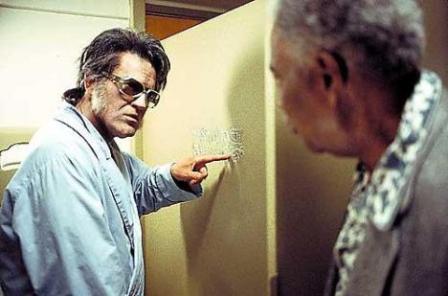 Time for a dual-review. Watching these films back-to-back highlights their similarities and their differences. Both are CGI-heavy sci-fi blockbusters, featuring mass destruction caused by other-worldly monsters. Both are also a product of a post 9/11 America.
Time for a dual-review. Watching these films back-to-back highlights their similarities and their differences. Both are CGI-heavy sci-fi blockbusters, featuring mass destruction caused by other-worldly monsters. Both are also a product of a post 9/11 America.Cloverfield is the most explicit in it's imagery and use of 9/11 - so explicit, it's almost like watching, experiencing it over again. We have New York, toppling skyscrapers, shaky hand-cam footage, crowds fleeing in blind terror and panic, clouds of dust billow through the streets, no-one knows what is going on, sheets of A4 paper float down from above.
The running time is a taught 84 minutes - for the first 20 minutes characters and motivations are established. Then all hell breaks loose. Something is ripping New York apart. For the next hour, we are pinned in our seats by all manner of tense, nervous panic as our party group is whittled down to a few core survivors as they try and make their way across Manhattan. Shocks are sudden and frequent as one tense location gives way to another. The hand-cam footage works a treat (though motion sickness maybe a side effect) as we only know and experience what our heroes experience.
Ultimately, the film has nothing to say, it's all about the experience. But what an experience.
 Transformers is a version of future war, and directed with all the sense and subtlety of the American invasion of Iraq. This is the Bush version of 9/11. The American Military is proud, upstanding and supportive of local indigenous populations around the world, only responding to growing threats. The camera lusts over anything American built with an engine, and Megan Fox. But it mainly lusts over a ridiculous number of explosions and military hardware with a fetishism that is creepy.
Transformers is a version of future war, and directed with all the sense and subtlety of the American invasion of Iraq. This is the Bush version of 9/11. The American Military is proud, upstanding and supportive of local indigenous populations around the world, only responding to growing threats. The camera lusts over anything American built with an engine, and Megan Fox. But it mainly lusts over a ridiculous number of explosions and military hardware with a fetishism that is creepy.The original Transformers cartoon series was decried in the 80s as being a half-hour advert for toys. This film takes it to extremes - it is a 150 minute advert for Hasbro toys, General Motors, Burger King, The Strokes, and most importantly, military service.
Most of the film, instead of having a plot moving towards a climax, was filler. Two hours were padded tedious comedy moments, "character development", pornographic shots of US military hardware in a sunset, gratuitous explosions and product placement.
This left half an hour of robot on robot action, by which time I'd ceased to care at watching two groups of pixels pretending to have a fight and which was edited, photographed and choreographed by a 14 year old boy with ADD on a sugar rush as to leave me wondering what the hell was going on.
As for 9/11 reference themselves - it seems that the only thing Michael Bay learned from 9/11 was that really big explosions and planes crashing into buildings (repeatedly) look really cool.
By all means, as a summer blockbuster, the film is entertaining enough. But it watches itself. We have seen this movie dozens of times before. I just felt the need to shower afterwards.










